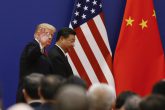June 10, 2024
Obama tried to pivot to Asia in 2011. We must succeed this time.
This article, originally published in The Washington Post, is an excerpt from Lost Decade: The US Pivot to Asia and the Rise of Chinese Power.
In 2011, President Barack Obama announced that the United States would, after centuries of preoccupation with Europe and decades of Middle East wars, put the Asia-Pacific region first. Washington would increase its military presence there, step up diplomacy, secure a regionwide trade deal and more.
Pivoting — or rebalancing — to Asia quickly won support among policymakers in both parties and across subsequent administrations. It coupled sound strategic logic with a keen appreciation of the ways in which the world was changing. By engaging more deeply with the region, the United States could better reap its economic promise and more effectively deal with a rising China.
China’s unique combination of power and determination to upend global order represents a generational challenge for American policymakers.
It was easier said than done. The United States established new basing and porting arrangements in the Asia-Pacific region, invested in new systems and research and development, and forged new defense relationships, all to the good. Yet in 2022, Washington had more troops in Europe than it did in 2011. High-end systems deployed routinely to the Middle East and not to Asia. And during this entire period, Chinese military power grew at an astonishing clip. The result has been a dramatic deterioration in the Asia-Pacific military balance away from the United States and its allies.
Meanwhile, China stepped up its diplomacy, forged new partnerships and increased its global engagement as U.S. attention wandered, depending on events and policymakers’ personal preferences. The Trans-Pacific Partnership, a 12-member trade agreement that was once a central economic initiative, crashed on the rocks of domestic political opposition. As President Donald Trump withdrew from the TPP, China emerged as the top trading partner of nearly every nation across the region.
Throughout the Obama and Trump years, the result was a lost decade in responding to China’s rise. Even if the pivot had been executed as intended, the United States would today still face a momentous challenge from China. But it would be far better prepared to take it on.
Read the full article from The Washington Post.
More from CNAS
-
Trump Heads to Asia with High-Stakes Meeting with China’s Xi on the Agenda
President Donald Trump departed Washington Friday night for Asia with trade and U.S. relations with China top of mind. He is set to hold a high-stakes sit-down with Chinese Pr...
By Jacob Stokes
-
Defense / Indo-Pacific Security
Is the U.S. Ready for War with China?U.S. military planners are caught in an impossible dilemma....
By Franz-Stefan Gady
-
North Korea Hardens Posture as Allies Recalibrate Before APEC
With President Trump set to attend the APEC summit in Gyeongju, questions are resurfacing about a possible return to U.S.–North Korea diplomacy. No working-level talks are und...
By Dr. Go Myong-Hyun
-
Sharper: India and the Quad
Despite recent bilateral challenges, India’s relationship with the United States and its leadership within the Quad remains indispensable for an Indo-Pacific that is cooperati...
By Keerthi Martyn & Charles Horn




